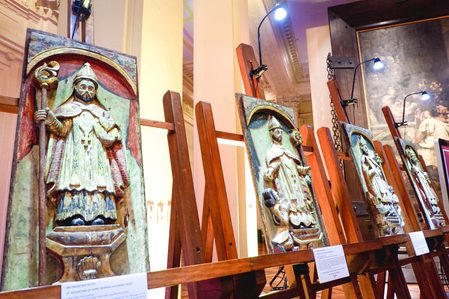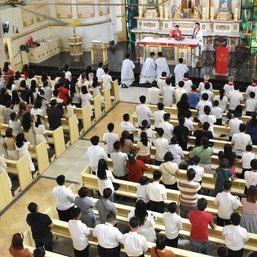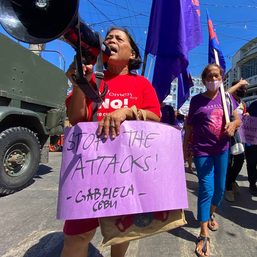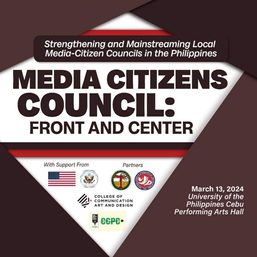SUMMARY
This is AI generated summarization, which may have errors. For context, always refer to the full article.
![[The Slingshot] Museology 101 for Andoni Aboitiz](https://www.rappler.com/tachyon/2024/03/TL-Museology-101-Boljoon-Church-panels-March-12-2024.jpg)
The issue of the stolen Boljoon Church artifacts landing in the hands of the National Museum of the Philippines (NMP) has become even more complex by its own making.
NMP board chairperson Andoni Aboitiz’s statement has turned the issue bizarre. He urged restraint in describing the objects as “stolen property.” But museum work is a work of honesty, performed no less by a trust of government such as the National Museum. Aboitiz does not know a thing about how important it is to establish provenance for every object the museum acquires.
Upon entering its catalogues of accession, an object that reaches the museum, whether by loan or by donation, is immediately recorded. The reason for that is conservation – future researchers and scholars will have a full grasp of the object’s complete history and origin. Where did the objects come from? They certainly did not come from the donors Edwin and Aileen Bautista. To negate the history of the object is dishonesty.
It is even more bizarre when that statement comes from Aboitiz. In 2016, the Ramon Aboitiz Foundation published The Pueblo of Bolhoon by Paul Gerschwiler. In 2009, Gerschwiler had also published “Boljoon: A Cultural Sketch” (publisher, The Foundry). In 2015, Aboitiz Foundation had also published Gerschwiler’s Argao: In Search of a Usable Past. Gerschwiler is a Swiss citizen who has called Argao, Cebu home. Gerschwiler’s Boljoon book published by Aboitiz Foundation provides a description of the same pulpit panels in the Boljoon Church.
The deed of donation states that the panels came from the “Church of the Roman Catholic Parish of Patrocinio de Maria Santisima in Boljoon, Cebu.” Aboitiz himself signed as a witness. Rappler’s Max Limpag obtained a redacted copy of the deed.
Does the NMP even orient its private sector board members of its museum collection policy? Every museum worth its salt should have one. What does it say about donated stolen objects?
Rule of thumb
Among the functions of the NMP board is this responsibility that now rests with Aboitiz as chairperson: “To consider and appropriately dispose of appeals regarding administrative decisions of the Head of Agency, where appropriate in line with pertinent laws and issuances.”
As a non-negotiable rule of thumb, any museum must not accept donations of stolen objects. The Bautistas did not steal it. Right. But where did the objects come from before they reached their hands? The answer is already found in the deed of donation that the Bautistas and the NMP signed. Barns’ statement that “the donors acquired it through legitimate means” obfuscates provenance. A museum director general should not say that. It is unethical on his part. He is expected to abide by international museum ethics standards. In this case, it is NOT unclear where the objects came from.
What about the Bautistas? Collectors cannot claim ignorance. Even if they had acquired the objects legitimately (say from a legally operating antiques dealer), the objects did not originate from that dealer. To say that they were donating them to the NMP as a “gift to the nation” is a smokescreen of the objects’ provenance. It might even make them liable for the same law that now stares the NMP in the face: Presidential Decree No. 1612. They signed on the deed that states the objects came from the Boljoon Church.
The Bautistas should have acted like the tipster in the return, by way of an Ikea bag, of Van Gogh’s “Parsonage Garden at Nuenen in Spring” to a Dutch museum. The tipsters offered the painting back in return for anonymity and no trouble. Then the NMP should have returned the objects to the Boljoon Church.
Every time NMP says the objects should stay with them, as the deed of donation specifies, is like protecting the object’s burglar each day it remains in the hands of the NMP. This should be the museum’s unequivocal policy: anybody possessing the Boljoon panels outside the Boljoon Church risks criminal guilt of the anti-fencing law.
Return them
NMP director general Jeremy Barns’ “dynamic ownership” is garbage. There is no such thing. What was stolen is stolen. Period.
Section 2 (a) of the Anti-Fencing Law of 1979 states that “Fencing is the act of any person who, with intent to gain for himself or for another, shall buy, receive, possess, keep, acquire, conceal, sell or dispose of, or shall buy and sell, or in any other manner deal in any article, item, object or anything of value which he knows, or should be known to him, to have been derived from the proceeds of the crime of robbery or theft.”
The issue on the Boljoon Church panels has become complicated because NMP refuses to be ethical. But there is no other ethical choice: the objects must be returned to the Archdiocese of Cebu who is its rightful owner.
Is NMP willing to face the complexity of being charged in court for fencing? – Rappler.com
Add a comment
How does this make you feel?









There are no comments yet. Add your comment to start the conversation.